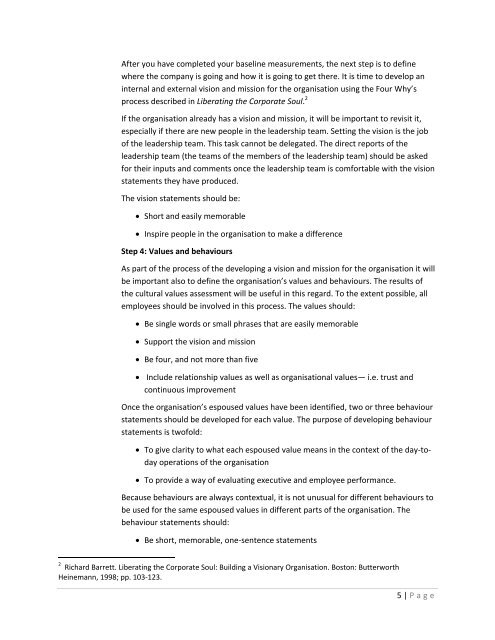Cultural Transformation
Cultural Transformation
Cultural Transformation
You also want an ePaper? Increase the reach of your titles
YUMPU automatically turns print PDFs into web optimized ePapers that Google loves.
After you have completed your baseline measurements, the next step is to define<br />
where the company is going and how it is going to get there. It is time to develop an<br />
internal and external vision and mission for the organisation using the Four Why’s<br />
process described in Liberating the Corporate Soul. 2<br />
If the organisation already has a vision and mission, it will be important to revisit it,<br />
especially if there are new people in the leadership team. Setting the vision is the job<br />
of the leadership team. This task cannot be delegated. The direct reports of the<br />
leadership team (the teams of the members of the leadership team) should be asked<br />
for their inputs and comments once the leadership team is comfortable with the vision<br />
statements they have produced.<br />
The vision statements should be:<br />
• Short and easily memorable<br />
• Inspire people in the organisation to make a difference<br />
Step 4: Values and behaviours<br />
As part of the process of the developing a vision and mission for the organisation it will<br />
be important also to define the organisation’s values and behaviours. The results of<br />
the cultural values assessment will be useful in this regard. To the extent possible, all<br />
employees should be involved in this process. The values should:<br />
• Be single words or small phrases that are easily memorable<br />
• Support the vision and mission<br />
• Be four, and not more than five<br />
• Include relationship values as well as organisational values— i.e. trust and<br />
continuous improvement<br />
Once the organisation’s espoused values have been identified, two or three behaviour<br />
statements should be developed for each value. The purpose of developing behaviour<br />
statements is twofold:<br />
• To give clarity to what each espoused value means in the context of the day‐today<br />
operations of the organisation<br />
• To provide a way of evaluating executive and employee performance.<br />
Because behaviours are always contextual, it is not unusual for different behaviours to<br />
be used for the same espoused values in different parts of the organisation. The<br />
behaviour statements should:<br />
• Be short, memorable, one‐sentence statements<br />
2 Richard Barrett. Liberating the Corporate Soul: Building a Visionary Organisation. Boston: Butterworth<br />
Heinemann, 1998; pp. 103‐123.<br />
5 | P age

















